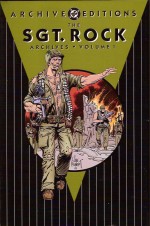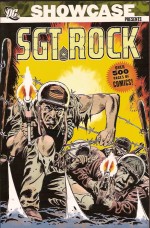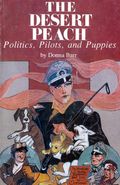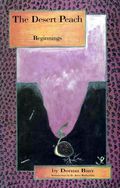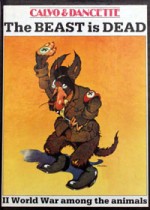
By Donna Barr (Aeon)
ISBN: 1-883847-04-4
The Desert Peach is the supremely self-assured and eminently accomplished gay brother of the legendary “Desert Fox†and one of the most perfectly realised characters in comics.
Set in World War II Africa and effortlessly combining hilarity, absurdity, profound sensitivity and glittering spontaneity, the stories describe the daily grind of Oberst Manfred Pfirsich Marie Rommel; a dutiful if unwilling cog in the German War Machine and his efforts to remain a perfect gentleman under the most adverse and unkind conditions.
As formidable as his beloved elder sibling Field Marshal Erwin Rommel, the gracious and genteel Peach is a man of breeding who loathes causing harm or giving offence and thus spends his dry and dusty days commanding the ever-so-motley crew of the 469th Halftrack, Gravedigging & Support Unit of the Afrika Korps, trying to remain stylish, elegant, civil and gracious to the men under his command, the enemy forces opposite him and all the unfortunate natives whose countries both Allied and Axis powers are currently running riot within.
It’s a lot of work: the 469th houses the worst dregs of the Wehrmacht, from malingerers and malcontents to useless wounded, sharpers, screw-ups and outright maniacs.
Pfirsich applies the same genteel courtesies and rule of well-manicured thumb to the sundry indigenes populating the area surrounding the camp and the rather tiresome British – not all of whom are party to a clandestine non-aggression pact Pfirsich has agreed with his opposite number in the opposing British Forces.
The romantic fool is passionately in love with and engaged to Rosen Kavalier: handsome Aryan warrior and outrageously manly Luftwaffe Ace: in fact the only people the Peach really has no time for are boors, bigots and card-carrying Blackshirts…
Arguably the real star of these fabulous frothy epics is the Peach’s long-suffering, unkempt, crafty, ill-mannered, bilious and lazily scrofulous orderly Udo Schmidt, a man of many secrets and non-existent morals whose one redeeming virtue is his uncompromising loyalty and devotion to the only decent man and tolerable officer in the entire German army.
This hard to find but supremely superb third monochrome compendium reprints issues #7-9 and includes an all-new tale too.
Battle commences with ‘The Spoiled Fruit’ as the mild mannered and utterly urbane Peach is accidentally dosed with shell-shocked veteran Corporal Doberman‘s anti-psychotic medication. The ghastly experimental brew acts like Angel Dust on the sweet lad and turns Pfirsich into a raging warmongering lunatic, who goes on a three day battle-jag, dragging the 469th with by sheer rampaging willpower and almost winning the desert war single-handed… until the drugs stop working.
Even more embarrassing than the death and bloodshed he caused and certainly more painful than the bullet wound in his posterior is brother Erwin awarding him a medal…
This is followed by international adventure and intrigue in ‘Dressing Down’ as an old-fashioned army concert-party leads to one of the most ludicrous espionage missions of the war.
In an attempt to raise morale Udo organises a show where he and a few other ranks dress up in drag. Although a little unhappy at the sordid and distasteful turn of events, Pfirsich lets it go but is horrified when an intelligence officer from his brother’s staff claims that Udo-as-a girl looks just like Hannah Mardi, a German agent currently missing in England.
She and her sister were the only hope of recovering the stolen plans for Rommel’s latest tank but for such a mission to succeed Hannah should be accompanied by her usual partner. What a happy coincidence that Pfirsich looks so much like the equally absent “Portia Sophiâ€: the Peach could pass for her with almost no make-up at all…
Arriving at the last known address of the missing spies in London, the terrified and mutinously reluctant Pfirsich and Udo are horrified to discover something very peculiar is going on in the agents’ old lodgings and things become surreal, hilarious and quite, quite tricky when the Peach realises that the landlady’s son Willie is the same delightful boy who befriended him in those carefree days before the war..
The reprints end with ‘Scourge of Love’ as the ever-horny Udo unwittingly turns a bargaining session for fresh rations with Tuareg traders into an accidentally proposal to the Chieftain’s beautiful daughter Falila.
He thought he was getting a “quickie†from a easy trollop but too soon Udo realises he was not only betrothed to the proud princess of a people who have turned avenging insults into an art-form and spectator blood-sport, but that to prove himself worthy he would have to steal a herd of camels from the Arabs’ greatest and most ancient enemies.
With a tribal revolt threatening to interfere with the smooth course of the war, Udo’s tenderest and most cherished organs at risk and, most importantly, the honour and happiness of a lady at stake, the Desert Peach has no choice but to step in and settle matters in his own uniquely sensitive and refined manner…
The new epilogue ‘Home is Where…’ is set in the Peach’s declining years, wherein Pfirsich and his adult son Mani play host to a reunion of the 469th few survivors: a bittersweet vignette which delights and fearfully foreshadows tragedies yet to come. This moving vignette also appears in Book 4 Baby Games.
Referencing the same vast story potential as Sgt. Bilko, Hogan’s Heroes, Oh, What a Lovely War! and Catch 22, as well as such tangential films as Priscilla, Queen of the Desert and The Birdcage, the Desert Peach is bawdy, raucous, clever, authentically madcap and immensely engaging.
These fabulously weird war stories were some of the very best comics of the 1990s and still pack the comedic kick of a floral-scented howitzer, liberally leavened with situational jocularity, accent humour and lots of footnoted Deutsche cuss-words for the kids to learn.
Pfirsich’s further exploits continue as part of the Modern Tales webcomics collective…
Illustrated in Barr’s fluidly seductive wood-cut and loose-line style, this book is a must-have for any history-loving, war-hating lover of wit, slapstick, romance and belly-laughs. All the Desert Peach books are pretty hard to find these days but if you have a Kindle, Robot Comics have just begun to release individual comicbook issues for anybody who can make their way around Das Ferslugginer Internetten …
© 1990-1994 Donna Barr. All rights reserved. The Desert Peach is ™ Donna Barr.



